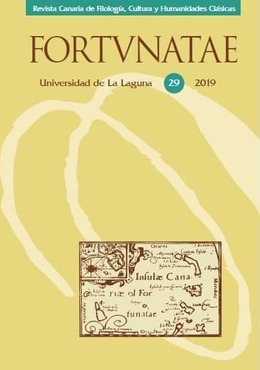Mucia Tercia: Matrona romana, mediadora política.Un estado de la cuestión
Resumen
En su reseña de La Revolución Romana, Arnaldo Momigliano menciona a Mucia Tercia, matrona romana del siglo I, conocida por ser esposa de Pompeyo (106-48) y madre de Sexto (ca. 66-35). Mucia fue un personaje de una fascinante existencia vital y una auténtica prueba viviente de la importancia de la mujer como agente político de influencia y repercusión en el último siglo de la República romana, que vio otros ejemplos de mujeres de similar trascendencia en la esfera de la alta política: Servilia, Fulvia; Julia, hija del futuro princeps; o la misma hermana de éste, Octavia, entre otras.
Citas
BABCOCK, C. L. (1965): “The early career of Fulvia”, The American Journal of Philology 86 (1): 1-32.
BRENNAN, T. C. (2012): “Perceptions of women’s power in the late Republic: Terentia, Fulvia, and the generation of 63 BCE”, en S. DILLON y S. L. JAMES (eds.), A Companion to Women in the Ancient World, Wiley-Blackwell, Oxford, Malden y Chichester, pp. 354-366.
BROUGHTON, T. R. S. (1968): The Magistrates of the Roman Republic vol. II [MRR II], The American Philological Association [reimp.].
CHRIST, K. (1993): “Die Frauen der Triumvirn”, en A. GARA y E. FORABOSCHI (eds.), Il Triunvirato constituente alla fine della Republica romana, Biblioteca di Athenaeum, Como, pp. 135-153.
DELIA, D. (1991): “Fulvia reconsidered”, en S. POMEROY (ed.), Women’s History and Ancient History, University of North Carolina Press, Chapel Hill, pp. 197-217.
DPRR = The Digital Prosopography of the Roman Republic [DPRR], Mucia (28) Tertia, en línea: http://romanrepublic.ac.uk/.
FISCHER, R. A. (1999): Fulvia und Octavia. Die beiden Ehefrauen des Marcus Antonius in den politischen Kämpfen der Umbruchzeit zwischen Republik und Prinzipat, Logos, Berlin.
FLUSS, M. (1933): “Mucius 28 (Tertia Mucia)”, Real-Encyclopädie der classischen Altertumswissenschaft 16 (1): 449.
GABBA, E. (1970): Appianus. Bellorum Civilium liber quintus, La Nuova Italia, Firenze.
HADAS, M. (1930): Sextus Pompey, Columbia University Press, New York.
HALEY, S. P. (1985): “The five wives of Pompey the Great”, Greece & Rome 32 (1): 49-59.
HARDERS, A.-C. (2015): “Consort or despot? How to deal with a queen at the end of the Roman Republic and the beginning of the Principate”, en H. BÖRM (ed.), Antimonarchic Discourse in Antiquity, Franz Steiner Verlag, Stuttgart, pp. 181-214.
HEMELRIJK, E. A. (2004): Matrona docta: Educated women in the Roman e lite from Cornelia to Julia Domna, Routledge, London.
HÖLKESKAMP, K.-J. (2004): Senatus populusque romanus: die politische Kultur der Republik: Dimensionen und Deutungen, Franz Steiner Verlag, Stuttgart.
HÖLKESKAMP, K.-J. (2017): Libera res publica: die politische Kultur des antiken Rom: Positionen und Perspektiven, Franz Steiner Verlag, Stuttgart.
HUMBERT, M. (1972): Le remariage a Rome. E tude d’histoire juridique et sociale, Giuffre , Milano.
LENDON, J. E. (1997): Empire of honour: the art of government in Roman World, The Clarendon Press, Oxford.
MASI DORIA, C. (2014): “Uno scandalo del 52 a.C. e la problemática identità di due donne romane (Nota su Val. Max. 9,1,8)”, en J. HALLEBEEK J. et alii (eds.), Inter cives necnon peregrinos: Essays in honour of Boudewijn Sirks , V&R Unipress, Göttingen, pp. 493-500.
MRR = BROUGHTON, 1968.
MOMIGLIANO, A. (1940): “Review of The Roman Revolution”, Journal of Roman Studies 30: 75-80.
SEAGER, R. (20022): Pompey the Great. A political biography, Blackwell, Oxford.
STEGMANN, H. (2000): “Mucia Tertia”, Der Neue Pauly 8, Metzler, Stuttgart-Weimar, pp. 423-424.
SYME, R. (1939): The Roman Revolution, The Clarendon Press, Oxford.
VIVAS GARCÍA, G. A. (2013): Octavia contra Cleopatra. El papel de la mujer en la propaganda política del Triunvirato (44-30 a. C.), Liceus, Madrid.
WELCH, K. (1995): “Antony, Fulvia and the Ghost of Clodius in 47 B.C.”, Greece & Rome 42 (2): 182-201.
WELCH, K. (2012): Magnus Pius: Sextus Pompeius and the transformation of the Roman republic, The Classical Press of Wales, Swansea.
ZMESKAL, K. (2009): Adfinitas. Die Verwandtschaften der senatorischen Fu hrungsschicht der ro mischen Republik von 218-31 v. Chr., K. Stutz, Passau.
Los autores conservan los derechos de autor y garantizan a la revista el derecho de ser la primera publicación del trabajo al igual que licenciarlo bajo una Creative Commons Attribution License que permite a otros compartir el trabajo con un reconocimiento de la autoría del trabajo y la publicación inicial en esta revista.
Los autores pueden establecer por separado acuerdos adicionales para la distribución no exclusiva de la versión de la obra publicada en la revista (por ejemplo, situarlo en un repositorio institucional o publicarlo en un libro), con un reconocimiento de su publicación inicial en esta revista.





